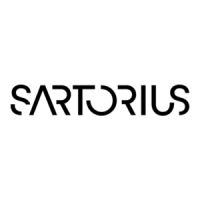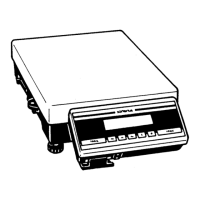Do you have a question about the Sartorius BP 34000 P and is the answer not in the manual?
Specifies allowable storage temperature and handling for safe transport and conditions.
Details environmental requirements for balance placement to ensure optimal performance.
Guides on connecting the balance to its electronics box using provided cables.
Instructions for assembling components for analytical and round glass draft shield chambers.
Details on connecting the balance to the AC power adapter and ensuring correct voltage.
Outlines safety measures for AC adapter use and data interface grounding.
Guides on safely connecting external devices like printers or PCs to the balance.
Advice on weighing electrostatically charged samples and adjusting the display unit.
Specifies balance warmup time and the automatic self-test procedure upon power-up.
How to activate or deactivate the balance display using the power key.
Explains how to zero the weight display for accurate weight determination.
Procedure for determining the weight of a sample placed on the weighing pan.
Steps for performing internal calibration using the built-in calibration weight.
Instructions for performing external calibration using external calibration weights.
Procedure to unlock the menu access switch and manage verified balances.
How to perform calibration tests and block calibration/adjustment functions.
Information on connecting peripheral devices via the data interface port.
Steps for using below-balance weighing with different balance configurations and antitheft device.
Recommends regular servicing and provides instructions for cleaning the balance.
Guidelines for inspecting the AC adapter and equipment for safe operation.
Explains how to select specific functions by setting menu codes.
Guide to access the balance menu, enter codes, and confirm settings.
How to exit without saving, undo all changes, and notes on menu locking.
Options for adapting to ambient conditions, weighing modes, and stability range.
Configuration for taring operation and the auto zero function.
Settings for internal linearization, external calibration, and blocking adjustment functions.
Parameters for data output, auto print, and defined interval settings.
Settings for automatic taring, application parameter output, and data ID codes.
Options for outputting tare memory data.
Functionality of menu access switch and methods for blocking balance keys.
Options for configuring the balance's power-on behavior.
Program for storing tare weight automatically for subsequent weighings.
A practical example demonstrating how to use the Tare Memory function.
Demonstrates obtaining printouts of tare, net, and gross weights.
Program to obtain weight readouts as a percentage of a reference weight.
How to change reference percentage, store weight, toggle readouts, and set display parameters.
A practical example for determining the dry weight of a sample.
Program for automatic conversion of weights into piece counts based on a reference sample.
How to display, change reference quantity, store weight, and toggle between counts and weight.
A practical example for counting bulk quantities of items with the same weight.
Program to determine weights of live animals or under unstable conditions by averaging.
Options for starting the animal weighing program and changing subweighing operations.
Settings to delay averaging and change the number of subweighing operations.
Sets a minimum load for reliability in automatic start mode.
A practical example of automatic animal weighing.
Guides on connecting devices for ISO/GLP compliant printouts or records.
Overview of connecting Sartorius balances to computers or peripheral devices.
Notes on electrical connections and potential interference when interfacing devices.
Details the format and structure for control commands sent to the balance.
Lists commands using upper-case letters or special characters for balance control.
Control commands for adapting the balance to different ambient conditions.
Lists commands using lower-case letters for balance function activation.
Defines data communication terms and explains handshake parameters for data transmission.
Covers output by print command, automatic data output, and higher output rates.
Lists general specifications for the Basicplus series of balances.
Explains the CE marking, its significance, and relevant directives for Sartorius equipment.
Outlines directives for electrical safety and legal metrology requirements for weighing instruments.
Describes services for initial installation, verification, and subsequent verifications.











